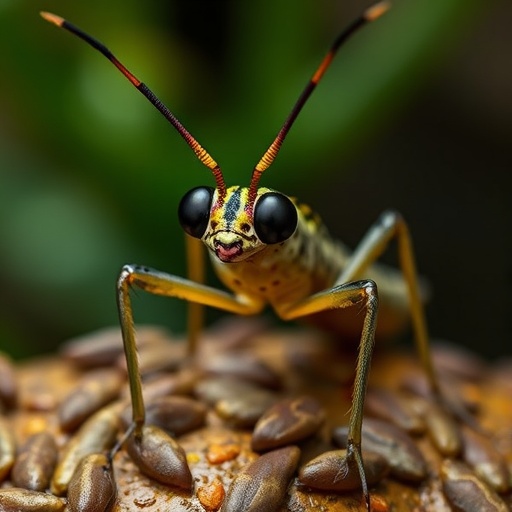In a groundbreaking study, researchers have unveiled the ovarian microrna transcriptome of Macrobrachium rosenbergii, a species of freshwater shrimp, following the widely researched procedure of eyestalk ablation. This surgical intervention, which is known to affect reproductive physiology in various crustaceans, has now been investigated at the molecular level, providing new insights into reproductive regulation mechanisms. The findings, published in BMC Genomics, highlight the importance of micrornas as regulatory elements in the reproductive systems of these aquatic organisms.
Eyestalk ablation involves the removal of the eyestalks, which are known to contain neurosecretory cells responsible for the production of hormones that regulate reproductive functions. By removing these structures, researchers can mimic a state that theoretically promotes reproductive development. The study conducted by Yuan and colleagues specifically analyzed the changes in the microrna transcriptome in response to this manipulation. The results underscore the role of micrornas as critical regulators in biological processes, particularly those related to reproduction.
The transcriptome analysis revealed a plethora of differentially expressed micrornas post-ablation. These micrornas are small, non-coding RNA molecules that play significant roles in post-transcriptional regulation of gene expression. The researchers identified numerous micrornas that were upregulated or downregulated following eyestalk ablation, suggesting a complex regulatory network governing reproductive functions in Macrobrachium rosenbergii.
Micrornas are crucial because they can modulate the stability and translation of messenger RNAs (mRNAs), leading to significant changes in protein expression. In the context of reproductive physiology, these gene regulators are vital as they can influence pathways associated with oogenesis, steroidogenesis, and gametogenesis. The alteration of specific micrornas following eyestalk ablation may serve as a molecular switch that initiates or suppresses reproductive development, thus having profound effects on the life cycle of this species.
The researchers used high-throughput sequencing techniques to analyze the microrna transcriptome, providing a comprehensive overview of the micrornas active during the phases after eyestalk ablation. The use of bioinformatics tools helped in identifying and characterizing these micrornas, allowing the researchers to correlate expression changes with known pathways involved in reproduction. What emerged is a refined understanding of how environmental and physiological changes drive molecular responses influencing reproductive traits.
The focus on the ovarian microrna transcriptome sheds light on a wider phenomenon observed in crustaceans and potentially other aquaculture species. The ability to manipulate reproductive physiology through surgical interventions opens doors to enhanced breeding programs aimed at optimizing yield and growth rates in aquaculture practices. With increasing demands for sustainable seafood production, this research paves the way for innovations in shrimp farming practices.
Furthermore, beyond its immediate implications for aquaculture, this research adds to our understanding of crustacean biology and the evolutionary adaptations these organisms have developed in response to environmental pressures. The environmental drivers of reproduction are complex and multifaceted; understanding the molecular switches can help researchers predict and manipulate breeding cycles in response to changing habitats.
The implications of this work extend to the broader field of genetics and molecular biology. Micrornas have become a focal point of research due to their versatility and ability to regulate numerous biological processes. This study highlights their role not only in fundamental biological studies but also in applied fields, such as agriculture and aquaculture, where understanding gene regulation can lead to significant advances in production efficiency.
As the global population continues to rise, ensuring food security has become a primary focus for scientists and policymakers alike. Research such as this one is vital as it explores how genetic and molecular manipulation can help to face challenges associated with food production. The findings suggest that micrornas will continue to be a crucial area of interest not only in reproductive biology but also in developmental biology, regenerative medicine, and even cancer research.
In conclusion, the unveiling of the ovarian microrna transcriptome in Macrobrachium rosenbergii contributes significantly to our understanding of reproductive regulation in crustaceans. This research not only offers insights into the molecular mechanisms that dictate reproductive success but also establishes a framework for future studies aimed at enhancing aquaculture practices. As the pressure on global food resources intensifies, work such as this becomes increasingly relevant.
The study was published with hopes of fostering further research on microrna applications across various species and encouraging cross-disciplinary collaboration. Future research directions may focus on the specific functions of identified micrornas, their targets, and the pathways they influence, creating a more detailed roadmap of reproductive biology in crustaceans.
These findings firmly establish a foundational understanding of how micrornas can function as molecular switches in reproductive regulation. Researchers and aquaculturists alike will benefit from deepening their comprehension of these regulatory systems as they pave the way for innovative solutions to global food challenges.
Strong collaboration between biologists, molecular geneticists, and industry professionals will be essential for translating these discoveries from the laboratory to practical applications. By harnessing the potential of micrornas, it is possible to envision improved strategies for shrimp production, ensuring both sustainability and efficiency in aquaculture. Moving forward, the establishment of comprehensive gene expression profiles and understanding their impacts on reproductive outcomes will be crucial for a new era of aquaculture science.
In summary, the comprehensive study conducted on the microrna transcriptome of Macrobrachium rosenbergii demonstrates the pivotal role of micrornas in reproductive regulation, providing a stepping stone for future investigations into crustacean biology and aquaculture.
Subject of Research: Ovarian microrna transcriptome of Macrobrachium rosenbergii after eyestalk ablation.
Article Title: Ovarian microrna transcriptome of Macrobrachium rosenbergii after eyestalk ablation: unveiling molecular switches in reproductive regulation.
Article References:
Yuan, H., Cheng, H., Peng, F. et al. Ovarian microrna transcriptome of Macrobrachium rosenbergii after eyestalk ablation: unveiling molecular switches in reproductive regulation.
BMC Genomics 26, 1017 (2025). https://doi.org/10.1186/s12864-025-12189-2
Image Credits: AI Generated
DOI: https://doi.org/10.1186/s12864-025-12189-2
Keywords: Macrobrachium rosenbergii, microrna, eyestalk ablation, reproductive regulation, transcriptome analysis, aquaculture




